When cloud computing was first coming into its own as an industry in 2011, the National Institute of Standards & Technology (NIST) published a landmark paper1 that laid out five core cloud computing characteristics, as well as four deployment models and three service models.
Although the paper lays out the essential characteristics of cloud computing, it’s not intended to be prescriptive or limiting, but merely serve as a fundamental taxonomy to provide a baseline for discussion. As defined by NIST, the key characteristics of cloud computing are: on-demand self-service, broad network access, resource pooling, rapid elasticity and measured service.
If you’re new to cloud computing, these terms might seem cryptic, but once you understand the basic terminology it becomes a good framework for understanding modern cloud computing platforms. Without further ado, let’s dive into more detailed definitions.
1. On-Demand Self-Service
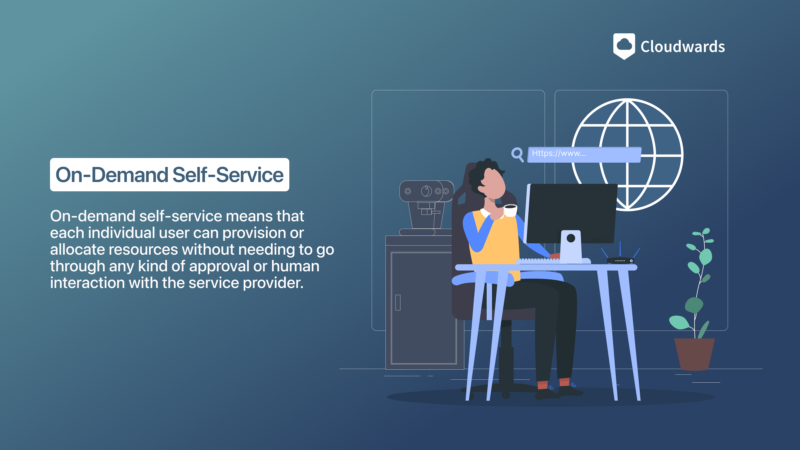
On-demand self-service means that each individual user can provision or allocate resources without needing to go through any kind of approval or human interaction with the service provider. Fundamentally, this is what makes cloud computing much more scalable than traditional on-premises solutions.
This characteristic is crucial to ensure both scalability and sustainability, as it would be impossible for a provider to manually provision resources based on request at scale. It also allows for pay-as-you-go pricing models for IaaS and PaaS solutions, rather than billing based on predetermined subscription plans.
For programmers and developers, this characteristic enables much greater flexibility in development, as resources can be rapidly provisioned and reallocated for testing purposes. For the consumer, the result is a smooth user experience that doesn’t experience slowdowns or bottlenecks due to slow resource allocation.
2. Broad Network Access
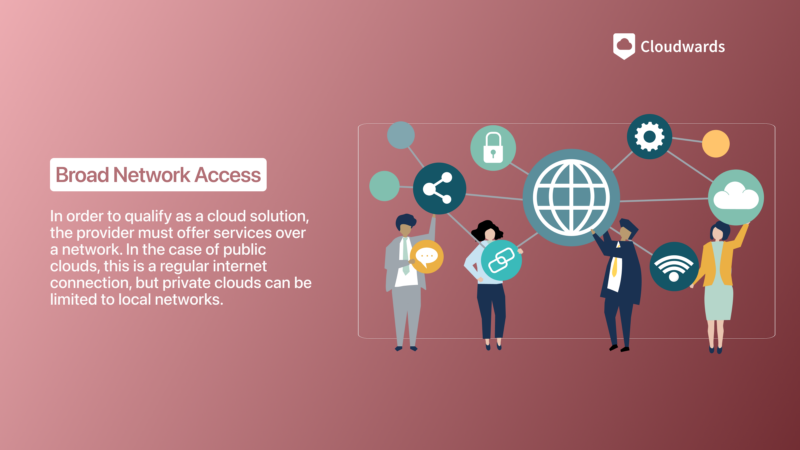
In order to qualify as a cloud solution, the provider must offer services over a network. In the case of public clouds, this is a regular internet connection, but private clouds can be limited to local networks.
Another important part of broad network access is that the access should be managed with standardized protocols, allowing for maximum flexibility for the user for choosing middleware clients and software.
Broad network access represents one of the key benefits of cloud computing across the board, in that users aren’t limited by physical location or VPN connection to access services and resources. Furthermore, standardized delivery protocols allow for greater specialization among the cloud service providers themselves, as cross-cloud integration becomes possible.
3. Resource Pooling
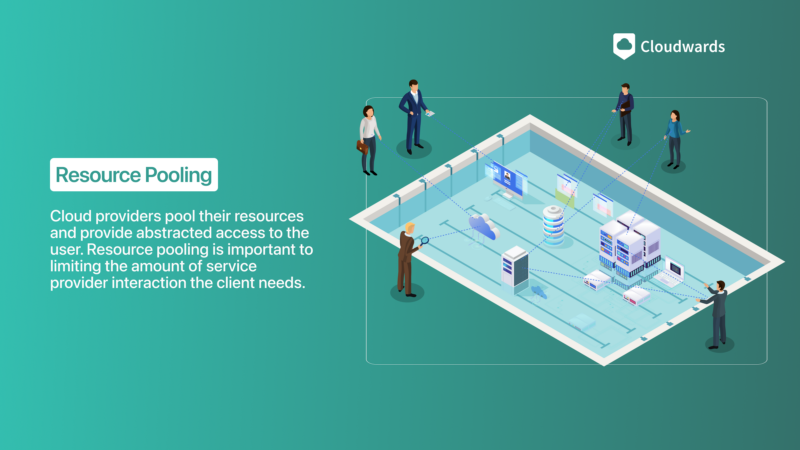
Cloud providers pool their resources and provide abstracted access to the user. This means that from the user’s perspective, there’s a virtually infinite amount of resources available, and details like the precise location of the physical servers and exact hardware specifications are kept out of the user’s view.
Resource pooling is important to limiting the amount of service provider interaction the client needs. Since all the platform’s resources are essentially fungible and mostly location-independent (aside from general signifiers like region, country or state) there’s no decision-making involved in the allocation process.
For any client, whether it’s a business, a general consumer or a software developer, this abstraction greatly simplifies any development process.
4. Rapid Elasticity
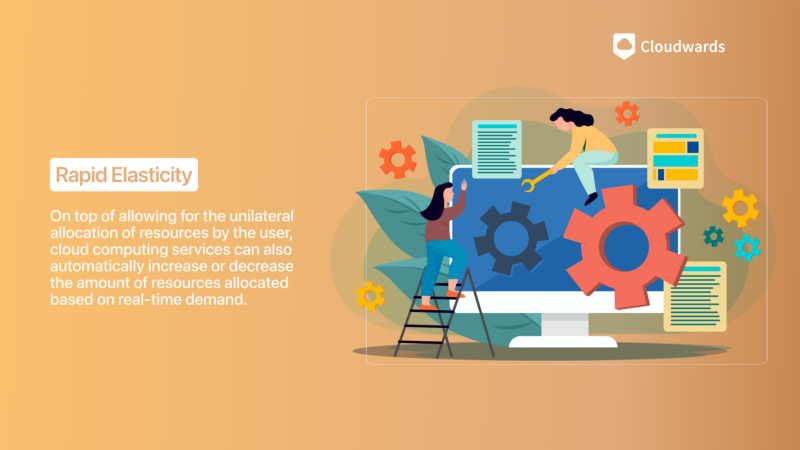
On top of allowing for the unilateral allocation of resources by the user, cloud computing services can also automatically increase or decrease the amount of resources allocated based on real-time demand. To achieve rapid elasticity on an on-premises system, the user would need a large amount of redundant hardware and infrastructure that sits idle during slow hours.
Rapid elasticity saves business users money from the simple fact that they don’t have to pay for infrastructure not being used during non-work hours or weekends. For any company that offers a consumer-facing IT product or service, such as an online store, website or application, rapid elasticity is crucial to avoid downtime and potential data loss during times of high load.
5. Measured Service
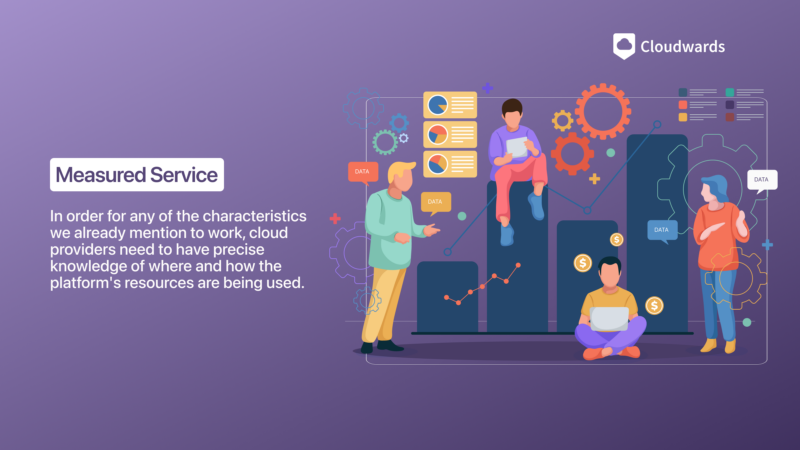
In order for any of the characteristics we already mention to work, cloud providers need to have precise knowledge of where and how the platform’s resources are being used. Aside from being fundamental to providing infrastructure services at all, it’s crucial for several different reasons, including billing, optimization and reporting.
In order for cloud services to charge according to usage, they first need to have an exact accounting of what has been used. Furthermore, analyzing usage patterns across all of a platform’s clients lets the provider optimize its infrastructure services for greater efficiency.
For users, not having to pay for idle infrastructure is an obvious benefit. Additionally, reporting on resource utilization can help optimize not only the service provider’s network, but the client’s workflows as well. For developers, getting insight into how users are interacting with their product is extremely valuable for quality assurance.
Other Important Cloud Computing Concepts
The NIST characteristics were defined all the way back in 2011 when cloud computing was an emerging field. Since then, other important concepts which partially overlap with the NIST characteristics have emerged.
Multi-Tenancy vs Single-Tenancy
Closely related to resource pooling is multi-tenancy. In fact, NIST’s definition of resource pooling includes multi-tenancy as a core component. Like resource pooling, it means that multiple clients (aka “tenants”) can use the same underlying infrastructure, down to individual hardware units, without their data ever coming into contact with each other.
Virtualization
Virtualization is a core component of cloud computing, enabling many of the key characteristics laid out by NIST. It allows for on-demand self service and resource pooling, as virtualization is what abstracts the underlying hardware. It’s also a key part of broad network access, as it’s necessary for standardized access to cloud resources.
Resilient Computing
Resilience in computing refers to a system’s capacity to withstand problems or outages. Because the resources of a cloud platform are practically infinite from the users’ perspective, there’s a tremendous amount of fault tolerance and redundancy present for each individual client.
Pay-Per-Use Pricing
As a result of the measured service characteristic, cloud vendors can charge users based on exactly the amount of resources they consume, rather than rely on fixed subscription prices or one-size-fits-all solutions.
Although SaaS products are still commonly billed through static subscription packages, IaaS and PaaS solutions are almost universally pay-per-use.
What Are the Principles of the Cloud Computing Model Defined by NIST?
The NIST cloud computing model lays out what’s known as the “5-4-3 principle,” which refers to the five characteristics already covered, four deployment models and three service models.
As an alternative to the model laid out by the NIST, the 2011 book ‘Cloud Computing: Principles and Paradigms’,2 written by multiple experts in the field and edited by researchers at the University of Melbourne, lays out six core principles of cloud computing. These are federation, independence, isolation, elasticity, customization and trust.
What Are the 5 Essential Characteristics of Cloud Computing as Defined by NIST?
The five essential characteristics of cloud computing defined by National Institute of Standards and Technology (NIST) are: on-demand self-service, broad network access, resource pooling, rapid elasticity and measured service.
What Are the 4 Deployment Models Defined by NIST?

The four cloud computing deployment models defined by NIST are public clouds, private clouds, hybrid clouds and community clouds.
Public Cloud
The public cloud deployment model refers to cloud service providers that offer IaaS, PaaS and SaaS solutions to third-party clients, usually on a subscription or pay-per-use model. Resources are pooled and shared between all clients with the cloud service provider owning all the hardware and physical infrastructure.
Private Cloud
Private clouds are either dedicated clouds, which are usually developed specifically for a single client or managed private clouds, which are similar to public clouds but with only a single tenant per solution. Dedicated clouds are usually hosted on hardware and infrastructure owned by the client, whereas managed private clouds use computing resources owned by the provider.
Hybrid Cloud
A hybrid cloud model is one that creates a bridge between a cloud solution (either private or public) and a traditional on-premises system. This is an especially common solution for businesses that handle some kind of sensitive or classified data, as anything covered by regulation can be left on-premises while less sensitive processes are moved to the cloud.
Community Cloud
Community clouds are private clouds that are shared between multiple organizations, but aren’t available to any paying customer like public clouds are. Community clouds are especially common for governmental agencies or non-profits where the benefits of collaboration are greater.
What Are the 3 Cloud Computing Service Models Defined by NIST?
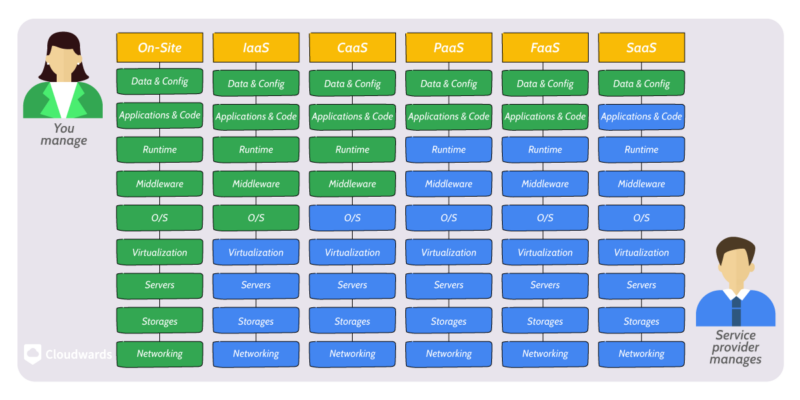
new models like FaaS and CaaS have emerged.
The three service models defined by NIST are software-as-a-service (SaaS), infrastructure-as-a-service (IaaS) and platform-as-a-service (PaaS).
SaaS
Software-as-a-service is the most familiar of the three service models to the average consumer. In this model, the cloud service provider manages every part of the solution, delivering an application or web interface that the end-user can interact with.
This model is used by everyday consumers for services like cloud storage, email and social media, but also by businesses for things like CRM, project management and collaboration.
IaaS

Infrastructure-as-a-service is the least managed version of cloud computing. This means that the cloud service provider offers only the infrastructure itself (namely data storage and processing power) and it’s up to the client to create applications, services and systems that use said infrastructure.
IaaS solutions are generally used by larger companies as they require hiring in-house developers or consultants to set up and maintain.
PaaS
Platform-as-a-service constitutes an additional layer of management on top of IaaS. The client still rents the infrastructure, but is also provided with abstracted access to the computing power and storage through various applications. This gives the user the ability to set up and customize standardized solutions using the cloud infrastructure without having to program it from scratch.
Since PaaS solutions are more abstracted than raw IaaS, they’re easier to use for smaller businesses as they can often be run by a single cloud architect certified with the relevant platform.
Other Cloud Computing Models: CaaS and FaaS
Since 2011, other service models like container-as-a-service (CaaS) and function-as-a-service (FaaS) have emerged, which can be considered similar to PaaS but with a much smaller scope.
Final Thoughts
That brings us to the end of our overview of the 2011 NIST paper and the cloud computing characteristics defined therein. Although the paper is a decent framework to help you understand cloud computing as a whole, the field has come a long way since then, so make sure to check out some of our other articles on the topic if you want to learn more.
What did you think of this guide? Do you feel like you’ve got a better grasp of cloud computing fundamentals and terminology? Did we miss any other important concepts not covered in the NIST paper? Let us know in the comments below. Thank you for reading.
FAQ: Characteristics of Cloud Computing
-
Cloud computing is a broad field that covers any kind of software or IT solution that’s delivered over the Internet. Features include anything from data storage to video conferencing to renting raw processing power and virtual machines.
-
The five characteristics of cloud computing, as defined by NIST, are on-demand self service, broad network access, resource pooling, rapid elasticity and measured service.
-
The four types of cloud computing deployment models are public, private, hybrid and community clouds.
The post The 5 Key Cloud Computing Characteristics & Other Important Concepts appeared first on Cloudwards.

